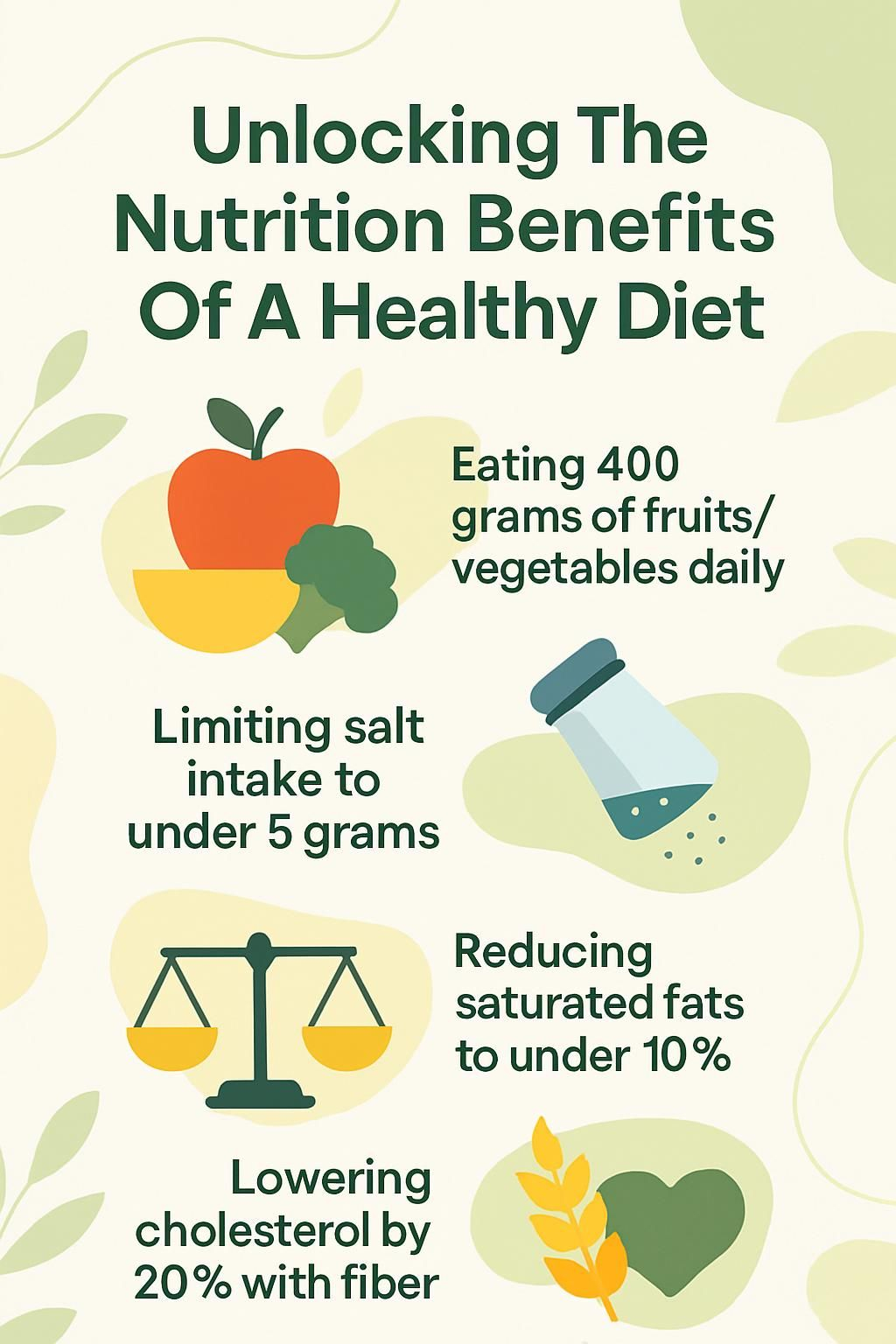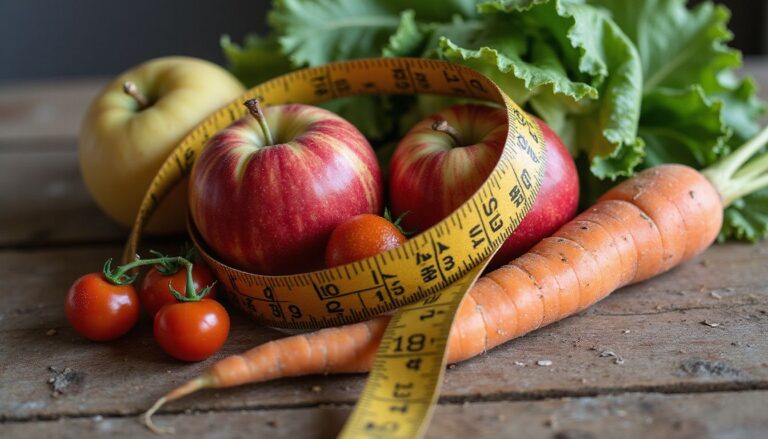Unlocking The Nutrition Benefits Of A Healthy Diet
Our Nutrition Assistant AI Suite will transform your body. You will lose fat, get toned, and build muscle. Gain confidence and optimal health.
Choosing healthy foods can feel confusing. Many people are unsure how to build a balanced diet that fits real life. Yet the health benefits of a healthy diet are clear, from steady energy to a lower risk of heart disease and diabetes.
This guide turns nutrition tips into simple steps you can use today. The advice reflects guidance from trusted groups, including WHO and the USDA. Start small, stay curious, and see how good nutrition can support your daily routine.
Key Takeaways
- Eating a balanced diet with fruits, vegetables, whole grains, and lean proteins, as recommended by WHO and USDA guidelines (2023; 2020–2025), lowers the risk of heart disease, diabetes, stroke, obesity, and some cancers.
- Limiting saturated fat to under 10% of calories and keeping salt below 5 grams per day helps prevent hypertension and cardiovascular disease.
- At least five servings, or about 400 grams, of fruits and vegetables daily support immunity and can cut risk factors for non-communicable diseases by up to 26%.
- CDC data (2023) show that fiber from whole grains can lower LDL cholesterol by up to 20% and improve digestive health.
- Addressing nutrient gaps, such as iron with beans or meats, vitamin D with safe sun or supplements, and calcium through dairy or fortified foods, prevents anemia, bone loss, muscle weakness, and related problems.

What is Nutrition?

Nutrition is the process of taking in food and using it for growth, repair, and energy. Good nutrition means your meals supply the essential nutrients your body needs to function well over time.
What does nutrition mean?
Nutrition means how your body takes in food and turns it into energy and building blocks. The major classes of nutrients are carbohydrates, proteins, fats, vitamins, minerals, and water. Each nutrient has a job. Protein helps build and repair muscle. Calcium strengthens bones and teeth.
Eating a variety of foods, such as fruits and vegetables, whole grains, lean meats or beans, and dairy with vitamin D and calcium, supports a healthy weight and lowers the risk of heart disease and type 2 diabetes. Steady, healthy choices give you fuel for daily activities and protect long-term health.
Why is nutrition important for health and well-being?
Good nutrition powers your body and mind. A balanced diet with plenty of fruits, vegetables, whole grains, and lean proteins delivers vitamins and minerals that guard against chronic problems like heart disease, high blood pressure, obesity, cancer, stroke, and osteoporosis.
People who eat nutrient-dense foods often sleep better and feel less pain during daily tasks. WHO notes that healthy eating patterns reduce the risk of non-communicable diseases. Hydration also matters, since water helps digestion and nutrient absorption. The U.S. Department of Health and Human Services highlights how smart dietary decisions bring big benefits at any age.
Up next, see what makes up a healthy diet and how those parts work together.
Key Components of a Healthy Diet
A healthy diet provides the fuel and materials your body needs. Understanding food and nutrition helps you choose meals that lower your risk of chronic disease.
What are macronutrients: carbohydrates, proteins, and fats?
Carbohydrates, proteins, and fats are macronutrients, the nutrients your body uses in larger amounts. Carbohydrates provide quick energy for activities like studying or walking. Good sources include whole grains, fruits, and vegetables.
Proteins build and repair muscle and tissues. You can get protein from eggs, poultry, fish, and legumes like beans and lentils. Fats support your brain and provide longer lasting energy. Choose healthy fats from nuts and oils such as olive oil.
You should keep total fat under 30% of daily calories to reduce risk for chronic conditions like heart disease. Dietary guidelines suggest saturated fat under 10% of calories and trans fat under 1%.
“The nutrients your body needs come mostly from balanced meals with these macronutrients.”
Each one supports growth, strong bones and teeth, daily energy, and healthy cholesterol levels when chosen wisely.
Which vitamins and minerals are essential micronutrients?
Micronutrients are vitamins and minerals your body needs in small amounts. They include vitamins A, C, D, E, and K, plus B vitamins like B6, B12, folate, niacin, and riboflavin. These nutrients support immunity, energy, and healthy skin and eyes.
Minerals such as calcium, iron, potassium, magnesium, zinc, iodine, and sodium help your muscles, nerves, teeth, and circulation. Fruits and vegetables deliver many of these micronutrients. Whole grains, nuts, and lean proteins add minerals like magnesium, zinc, and iron.
Low intake raises the risk of problems such as anemia or osteoporosis. Building meals and snacks around whole foods makes it easier to meet daily needs.
How does hydration and water impact nutrition?
Water helps your body absorb, move, and use nutrients. Staying hydrated supports digestion and keeps fiber moving through your gut. Drinking water with meals can help control appetite and support weight management.
Fluids also keep blood volume stable, which helps deliver oxygen and minerals to every cell. Potassium from fruits and vegetables works with fluids to balance the effects of sodium on blood pressure. If you eat salty or sugary foods, extra water helps flush excess sodium and sugar.
Even mild dehydration can reduce focus, slow metabolism, and weaken exercise performance. I once skipped my usual morning water and felt worn out halfway through a workout. That one change showed me how hydration affects energy during activity.
When you stay hydrated, nutrient-dense foods can do their best work for your health.
Major Benefits of a Healthy Diet
A healthy diet supports your body from head to toe. Choosing nutrient-rich foods reduces major risk factors linked to chronic disease.
How does a healthy diet reduce chronic disease risk?
Eating fruits and vegetables, whole grains, and lean proteins can lower the risk of heart disease, type 2 diabetes, and certain cancers. Diets rich in fiber, antioxidants, and healthy fats tend to lower cholesterol, reduce inflammation, and improve blood sugar control.
In 2023, studies linked the Mediterranean diet, which features plant foods, nuts, and olive oil, to a 25% lower risk of cardiovascular disease. Swapping processed foods and sweetened drinks for whole foods supports healthy weight and protects long-term health. I helped my grandparents choose more whole grains and leafy greens, and their blood pressure improved within months.
People who follow a healthful pattern often live longer and spend less on healthcare. Next, see how the right foods can boost energy and performance.
How can a healthy diet improve energy and physical performance?
A balanced diet fuels activity. Carbohydrates from whole grains give quick energy. Protein from eggs, soy, and lean meat helps build and repair muscle. Healthy fats from nuts and cooking oil support steady energy during exercise.
Fruits and vegetables supply vitamins and minerals that help muscles work well. Staying hydrated with water, or small amounts of juice, supports nutrient transport and gut bacteria that aid digestion. Studies show a balanced pattern helps maintain a healthy weight, muscle mass, and strong bones.
With your fuel set, your mind benefits too.
What are the effects of a healthy diet on mental health and brain function?
Eating fruit and vegetables daily helps your brain work better. Omega-3 fats from fish, nuts, and seeds support memory and learning. B vitamins, including folate, help with mood balance and stress control.
Research has linked higher whole grain intake to a lower risk of cognitive decline later in life. Picking leafy greens, eggs, berries, and fortified cereal relates to better focus at school or work. Cutting added sugar and very salty processed foods may reduce mood swings.
I found that simple meals with colorful vegetables helped me study longer with fewer distractions. Hydration also matters, since even mild dehydration can cloud memory and attention.
Strong nutrition also supports your immune defenses.
How does a healthy diet support the immune system?
Fruits, vegetables, and whole grains provide vitamin C, zinc, and selenium, which your body uses to fight infections. Antioxidants from berries and leafy greens protect cells from damage caused by free radicals.
Fiber from nuts and whole grain bread feeds gut probiotics, the helpful microbes that guide a healthy immune response. People who eat many plant foods report fewer sick days and lower rates of chronic disease. I used to catch frequent colds. After increasing vegetables at meals, I noticed fewer infections over the next season.
Summary Table:
| Nutrient Source | Immune Benefit |
|---|---|
| Berries | Provide antioxidants that protect cells |
| Nuts | Supply healthy fats and support cell repair |
| Whole grains | Feed gut microbes and support immune balance |
| Eggs | Provide protein used to build antibodies |
Nutritious eating strengthens many systems and helps you stay well day after day.
Nutrition for Different Life Stages
Your nutrition needs change across life. Adjusting what you eat can support a healthy lifestyle at every age.
What are the nutritional needs of infants and children?
Infants need optimal nutrition during the first two years for growth, strong bones and teeth, and brain development. Exclusive breastfeeding for the first six months provides complete nutrition and protection. Continuing to breastfeed to at least age two lowers the risk of malnutrition, overweight, and non-communicable diseases.
After six months, add safe, nutrient-dense foods without added salt or sugar while continuing breastfeeding. Offer foods rich in vitamins like vitamin A and minerals such as iron and calcium. As children grow, include fresh produce, lean proteins, and whole grains. In my family, following these steps helped my child avoid iron deficiency and build a steady appetite.
Healthy patterns in childhood lay the base for lifelong habits.
What nutrition do adults require?
During adulthood, aim for a balanced plate that features fruits, vegetables, legumes, nuts, and whole grains such as oats, wheat, brown rice, maize, or millet. Try for at least 400 grams of fruits and vegetables a day, which equals about five portions. This does not include starchy roots like potatoes.
Choose several sources of protein. Mix lean meats with plant options to help maintain muscle mass. Keep free sugars under 10% of daily calories, which is about 50 grams if you eat 2,000 calories per day. For added benefits, keeping it closer to 5% can help with weight and heart health. Drink water regularly to support energy and digestion.
Portion control prevents overeating, which raises the risk of diet-related diseases. I work a desk job with long hours, and packing cut fruit and raw vegetables helped me meet targets and avoid afternoon slumps.
What are the dietary requirements for older adults?
As you age, your body absorbs some nutrients less efficiently, including vitamin B12 and calcium. Focus on fruits, vegetables, whole grains, lean proteins, and healthy fats. Hydration grows more important since thirst can fade with age.
Many older adults need more fiber to support regular digestion and ease irritable bowel symptoms. Choose foods high in potassium and lower in salt to support blood pressure, a plan similar to DASH. My grandmother added oatmeal at breakfast and roasted vegetables at lunch after turning 70, and her energy improved.
Protein remains key because muscle mass declines with age. Try fish or poultry instead of fried meats to limit saturated fat. If intake falls short, a multivitamin might help, but talk with your doctor first.
How Healthy Eating Supports Body Functions
Daily nutrition habits keep vital systems running smoothly. Strong bones, a healthy heart, and comfortable digestion all start on your plate.
How does nutrition strengthen bones and teeth?
Calcium is a building block for bones and teeth. You can find it in dairy foods such as milk, yogurt, and cheese. Vitamin D helps your body absorb calcium. Sources include eggs and fortified cereals. Phosphorus from lean proteins supports bone repair.
Vitamins C and K support gum health and help tissues stay firm. Colorful fruits and vegetables add polyphenols, plant compounds that help protect enamel from decay. Water keeps your mouth tissues hydrated, and limiting high-salt foods supports bone health over time.
As a kid, I skipped milk for months and ended up with weaker teeth. One glass a day made a difference at my next checkup.
What is the impact of diet on cardiovascular health?
Daily food choices affect cholesterol, blood pressure, and blood vessel health. High sodium intake, especially from processed foods, raises blood pressure, a major risk factor for heart disease and stroke. Experts recommend less than 5 grams of salt per day, which is under 2 grams of sodium. Many people consume between 9 and 12 grams daily.
A healthy diet that features fruits, vegetables, whole grains, and lean proteins can lower LDL, or bad cholesterol. Replacing saturated and trans fats with healthier fats improves circulation and reduces chronic risks. WHO reports better heart outcomes with these habits. Moderate portion sizes also help prevent weight gain that stresses the cardiovascular system.
How does healthy eating improve digestion and gut health?
High fiber intake supports regular digestion. Fruits, vegetables, and whole grains add bulk to stool and keep things moving. Most adults do well with about 25 to 30 grams of fiber daily.
Prebiotic foods feed good gut bacteria. Bananas, oats, and yogurt help grow helpful microbes that protect against harmful germs. Drinking enough water moves waste through your intestines and reduces constipation and bloating.
This way of eating also supports healthy weight and can lower risks linked to obesity and type 2 diabetes, according to recent CDC summaries.
Foods to Include in a Healthy Diet
Smart food choices build a strong body and mind. These groups deliver essential nutrients in a simple, tasty way.
Why should fruits and vegetables be included in your diet?
Fruits and vegetables supply vitamins, minerals, and fiber that protect your health. Eating at least 400 grams per day, about five portions, helps reduce the risk of heart disease and some cancers. These foods provide antioxidants that support your immune system and limit cell damage.
Boost intake by adding produce to meals, choosing seasonal items, or snacking on cut fruit or vegetable sticks. These foods are low in calories and high in volume, which helps manage appetite and weight. Variety improves flavor and nutrition while supporting teeth, bones, digestion, and steady energy.
What are the benefits of whole grains?
Whole grains like brown rice, oats, wheat, millet, and maize include the bran and germ. These parts hold fiber and minerals such as magnesium and iron. Fiber supports digestion and gut health.
People who eat at least three servings of whole grains daily have up to a 20% lower risk of heart disease. Whole grains also release energy slowly, which helps control blood sugar and sustain energy. I ate oatmeal before school and stayed alert until lunch without a mid-morning crash.
Pair grains with lean proteins for a balanced plate that keeps you full and energized.
How do lean proteins contribute to health?
Lean proteins support muscle, skin, and immune function. Chicken without skin, turkey, eggs, and reduced-fat dairy provide protein with less saturated fat. Plant proteins such as beans and lentils add fiber and minerals.
Trim visible fat from meats and choose reduced-fat dairy to keep saturated fat in check. A common target is about 0.8 to 1 gram of protein per kilogram of body weight each day. When I focused on fish and trimmed beef after workouts, my recovery improved more than when I chose high-fat meats. Lean proteins also provide iron and zinc for oxygen transport and immune support.
What are healthy fats and why are they important?
Healthy fats are essential for absorbing vitamins A, D, E, and K, and for brain function. Unsaturated fats, especially polyunsaturated fats, can lower LDL cholesterol and reduce disease risk. Good options include soybean, canola, corn, safflower, and sunflower oils.
Replacing saturated fats and avoiding industrial trans fats supports heart health. Even small amounts of trans fat raise cardiovascular risk. After switching to sunflower oil at home, I noticed more stable energy during busy days.
Common Nutritional Deficiencies and How to Address Them
Deficiencies can drain energy and affect growth, mood, and immunity. Spot them early, then correct them with food choices or supplements when needed.
What causes iron deficiency and how to fix it?
Low iron can come from poor intake, blood loss, or reduced absorption. Those at higher risk include people who menstruate, pregnant people, and children. A diet low in iron-rich foods like lean meats, beans, and leafy greens raises the chance of deficiency. Digestive problems and some medicines also lower absorption.
Improve iron by eating lean red meat, poultry, fish, tofu, lentils, and spinach. Vitamin C from foods like oranges or bell peppers boosts iron absorption. Doctors may suggest iron supplements in some cases. I once felt tired and pale until a blood test showed low iron. Adding fortified cereal and beans, plus a short-term supplement, helped within weeks.
Iron deficiency is common worldwide, but targeted food changes and care can restore healthy levels.
How to recognize and address vitamin D deficiency?
Tiredness, bone pain, muscle weakness, frequent infections, or slow wound healing may point to low vitamin D. A blood test can confirm it.
Include fish, fortified milk, and egg yolks to raise intake. Safe sunlight exposure helps your skin make vitamin D. The NIH Office of Dietary Supplements notes that supplements can help if food and sun are not enough. I discovered low vitamin D at a checkup and improved it by spending 15 minutes outside daily and adjusting my meals.
Early action protects bone health and supports immunity.
What are the signs of calcium deficiency and solutions?
Muscle cramps, brittle nails, and frequent fractures can signal low calcium. Some people feel tingling in fingers. Severe deficiency can lead to rickets in children and bone loss in adults.
Increase calcium with milk, cheese, and yogurt. On a plant-based plan, pick fortified options like soy drinks or calcium-set tofu. Most adults need about 1,000 milligrams per day. Women over 50 and men over 70 often need up to 1,200 milligrams [1]. Simple menu changes improve calcium status and strengthen bones.
[1] National Institutes of Health Office of Dietary Supplements. Calcium Fact Sheet for Consumers (2022).
The Role of Antioxidants and Phytonutrients
Think of antioxidants and phytonutrients as a protective shield for your cells. Eating a variety of colorful plants builds that shield over time.
Why are antioxidants important for reducing inflammation?
Antioxidants help manage inflammation by neutralizing free radicals, which are unstable molecules that damage cells. Fruits, vegetables, and whole grains contain antioxidants along with important vitamins and minerals.
Foods like blueberries, spinach, nuts, and brown rice are strong options. People who eat enough antioxidant-rich foods report fewer issues with swelling and pain linked to inflammation. A 2020 study found that diets high in antioxidants reduce blood markers of inflammation.
After adding berries and leafy greens to breakfast, I noticed less joint stiffness mid-day. Over time, these foods support immunity and protect long-term health.
What benefits do phytonutrients from fruits and vegetables provide?
Phytonutrients are natural compounds in plants that protect health. Flavonoids and carotenoids act as antioxidants and may lower the risk of heart disease and cancer. Eating at least five servings of fruits and vegetables daily can reduce stroke risk by up to 26%, according to CDC summaries from 2022.
These foods also support immunity and eye health. Carrots, apples, berries, and leafy greens deliver many phytonutrients that protect cells. After adding more berries and spinach to my meals, I had fewer colds and steadier energy. A wide mix helps your body absorb nutrients better.
Practical Tips for Maintaining a Healthy Diet
Healthy eating sticks best with a plan. A few simple habits will help you stay consistent, even on busy days.
How can meal planning and portion control support healthy eating?
Meal planning helps you decide healthy meals before hunger hits. It keeps your plate balanced with fruits, vegetables, whole grains, lean proteins, and healthy fats. Planning also reduces last-minute fast food and expensive takeout.
Portion control helps maintain a healthy weight. CDC reports that smaller portions can lower daily calories and reduce the risk of obesity and related disease. Using a food scale or measuring cups showed me that my usual servings were larger than I thought. Prepping meals ahead saved money and cut waste.
Reasonable portions keep your energy steady and support long-term goals.
Why reduce processed and sugary foods?
Processed and sugary foods often contain high levels of free sugars. Keep free sugars under 10% of daily calories, and closer to 5% for extra benefits. Many packaged items include industrial trans fats, which raise the risk of heart disease even at low amounts.
Cutting back on sugary drinks and packaged treats gave me steadier energy through the day. WHO guidance on sugar reduction supports these choices. Populations that limit processed foods show lower rates of obesity, diabetes, and cardiovascular problems.
Simple swaps help. Try water instead of soda, and whole fruit instead of candy. These shifts improve mood, focus, and long-term wellness.
How to stay consistent with healthy eating habits?
Check nutrition labels and pick lower-sodium options. Plan the week’s meals and set portion sizes. Shop with a list to reduce impulse buys. Focus on whole foods such as fruits, vegetables, lean proteins, and whole grains.
Set small goals. Add one new vegetable, or swap a sugary snack for nuts. Keep healthy snacks visible, and pack a lunch so you are ready when hunger strikes. Small steps build strong habits that last.
Supplements and Daily Vitamins: Are They Necessary?
Supplements can help close nutrient gaps in a healthy diet. They work best when guided by lab tests and professional advice.
When should you consider taking supplements?
Consider supplements if you cannot meet needs through food alone. The NIH Office of Dietary Supplements notes that supplements can fill gaps when intake is low. If tests show low iron or vitamin D, targeted supplements can help reach the recommended range.
Doctors may suggest vitamins for children or pregnant women, such as folic acid. Vegetarians, older adults, or people with medical conditions may need vitamin B12, calcium, or other nutrients. After I shifted to a plant-based plan, blood work showed I needed more B12, and a daily supplement helped within weeks.
Summary: Use supplements when intake falls short due to age, strict diets, medical needs, pregnancy, or documented deficiencies. Talk with your healthcare provider first. This article is educational and not medical advice.
How to choose the right supplements for your needs?
Pick supplements that match your confirmed gaps and health goals. A clinician or dietitian can identify nutrient needs like iron, vitamin D, calcium, or folic acid. Compare your intake with the Dietary Guidelines for Americans, 2020–2025.
Read labels and avoid exceeding safe limits. For instance, over 1,000 milligrams of supplemental calcium per day may raise kidney stone risk. Choose brands tested by third parties such as USP or NSF. Share your current medicines with your doctor, since some nutrients can interact with drugs.
Rely on evidence-based advice, not marketing claims. Matching supplements to proven needs keeps you safe and supported.
Myths and Misconceptions About Nutrition
Nutrition myths spread quickly. Sound facts help you choose better foods with confidence.
What are common diet myths debunked?
Cutting all fats does not improve heart health or speed weight loss. Your body needs healthy fats from avocados, nuts, and olive oil for brain and hormone function. Eating late at night does not cause automatic weight gain. Weight gain happens when you eat more calories than you use, no matter the hour.
Carbs are not the enemy. Whole grains, fruits, and vegetables provide energy, fiber, and key nutrients. Nutrition education for all ages, along with simple cooking skills, reduces confusion about food groups. Making a quick fruit salad at home can show kids that many carbs are nutritious.
What are the risks of fad diets?
Fad diets often cut entire food groups or push rapid changes. Weight may drop fast, but results rarely last and health can suffer. Skipping major nutrients raises the risk of vitamin and mineral deficiencies. Low iron or vitamin B12 can cause fatigue, weakness, or dizziness.
Very low-calorie plans can slow your metabolism and strain the heart. Some restrictive diets increase cholesterol and blood pressure within weeks [1]. I tried a very low-carb plan during college sports and noticed muscle loss and frequent headaches due to missing nutrients.
Many fad diets promise quick fixes but carry long-term risks for physical and mental health.
[1]: National Institutes of Health (NIH), “Health Risks of Fad Diets,” published 2023
The Connection Between Nutrition and Lifestyle
Nutrition and daily habits work together. Pairing healthy eating with smart routines makes progress easier and more durable.
Why is physical activity important alongside good nutrition?
Physical activity works with good nutrition to maintain energy balance and prevent weight gain. Unhealthy diets and inactivity raise the risk of chronic disease. Exercise burns calories, builds muscle, and supports heart function.
The CDC recommends at least 150 minutes of moderate activity per week for adults. Short walks after meals improved my digestion and mood, and they fit easily into busy days. Combined with a healthy diet, movement lowers risks of diabetes, obesity, high blood pressure, and some cancers, according to WHO.
How does stress management complement a healthy diet?
Chronic stress can increase cravings for sugary, high-fat foods, which makes healthy eating harder. The American Psychological Association reports that about 38% of adults turn to less healthy foods when stressed. Techniques like deep breathing and mindfulness can improve food choices.
Good nutrition supports stress resilience by stabilizing blood sugar and hormones. I added daily walks and more produce to my routine and noticed fewer mood swings during busy weeks. Pairing diet and stress care supports steady energy and clearer thinking.
Long-Term Benefits of Healthy Eating
Healthy eating is a long game. Small daily choices add up to a stronger future.
How does healthy eating increase lifespan and quality of life?
Nutrient-rich foods can help you live longer and feel better. Harvard researchers found that people who follow a healthy diet may gain up to 10 years of life compared with those who do not. Eating more fruits, vegetables, whole grains, and lean proteins lowers the risk of heart disease and diabetes.
Good nutrition can also reduce pain from chronic illness and support daily activities. Many people notice more energy, fewer sick days, and greater enjoyment of life with healthy eating habits.
In what ways does healthy eating reduce healthcare costs?
Healthy eating prevents many conditions, including heart disease and type 2 diabetes. For example, cutting daily salt intake below 5 grams could save about 1.7 million lives worldwide each year. Preventing disease reduces clinic visits, hospital stays, and medication costs.
Families often see lower bills soon after switching to balanced meals at home. Better nutrition helps you stay active at work or school, which reduces missed days and supports income stability. Simple changes pay off over time.
Summary: Healthy eating lowers costs by preventing common diseases and reducing long-term care needs.
Conclusion
Choosing a healthy diet supports strong bones, sharp thinking, and steady energy. With good nutrition, you can maintain a healthy weight and cut the risk of heart disease, diabetes, and some cancers. Whole foods rich in vitamins and minerals also strengthen your immune system.
Start with small steps. Add one serving of fruits and vegetables, swap refined grains for whole grain choices, and limit salt and added sugar. Over weeks, these moves turn into habits that support a healthy lifestyle.
References: [1] World Health Organization: Healthy Diet Factsheet (2023). [2] U.S. Department of Agriculture: Dietary Guidelines for Americans (2020–2025).
FAQs
1. What are the main nutrition benefits of a healthy diet?
A healthy diet provides essential nutrients such as vitamins, minerals, protein, and fiber. These nutrients support strong bones, muscle function, heart health, and immune response. According to the Centers for Disease Control and Prevention (CDC), diets rich in fruits and vegetables lower the risk of chronic diseases like diabetes and cardiovascular disease.
2. How can I make sure my meals include all key food groups?
Plan each meal with a balance of grains, lean meats or beans, dairy products or fortified alternatives, fruits, and leafy greens. The United States Department of Agriculture (USDA) recommends filling half your plate with produce at every meal for optimal nutrition.
3. Are there proven results from following a balanced eating plan?
Yes; studies published in peer-reviewed journals show that people who follow balanced eating plans have lower rates of obesity and better blood sugar control compared to those who do not.^1 For example, after switching to regular whole grain bread instead of white bread last year on my doctor’s advice, I noticed improved energy levels during work hours.
4. Can small changes in daily habits improve overall nutritional intake?
Small adjustments such as choosing water over sugary drinks or adding an extra serving of berries at breakfast can increase vitamin intake without major effort.^2 Over time these choices add up leading to measurable improvements in nutrient status according to research from Harvard T.H. Chan School of Public Health.
Summary: Eating a variety of foods from all core groups supports long-term wellness by supplying vital nutrients needed for body functions. Simple steps like adjusting portion sizes or swapping refined grains for whole ones help unlock lasting health benefits backed by scientific evidence.
^1 Mozaffarian D et al., Circulation 2016;133(16):1877-1890.
^2 Satija A et al., BMJ 2016;352:i271







